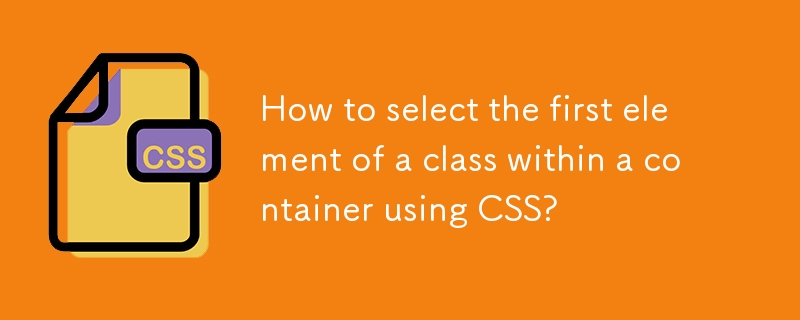 Web Front-end
Web Front-end
 CSS Tutorial
CSS Tutorial
 How to select the first element of a class within a container using CSS?
How to select the first element of a class within a container using CSS?
How to select the first element of a class within a container using CSS?

CSS Selector to Select First Element of a Given Class
In web development, selecting specific elements on a web page is crucial for styling and functionality. One common task is selecting the first occurrence of an element with a particular class within a broader hierarchy.
Consider a scenario where you need to select the first element with class 'A' within an element with id or class 'B'. While the combination of '>' and 'first-child' selectors can work in some cases, it fails when the position of the 'A' element varies within the 'B' element hierarchy.
CSS3 Solution: :first-of-type
CSS3 offers a solution through the :first-of-type pseudo-class, which allows you to select the first element of a specified type in relation to its siblings. However, CSS3 does not include a :first-of-class pseudo-class.
Workaround Using the General Sibling Combinator (~)
As a workaround, you can use the general sibling combinator (~) in conjunction with CSS overrides to achieve the desired result. The ~ selector matches any element that is a sibling of the element selected by the left-hand selector, but not a direct child.
Consider this rule:
.C > * > .A {
/* Style every .A that's a grandchild of .C */
}This rule selects every element with class 'A' that is a grandchild of an element with class 'C'. It assumes that '.C' is a common ancestor of all the 'A' elements you want to style.
Next, add an overriding rule:
.C > * > .A ~ .A {
/* Style only the .A elements following the first .A child of each element that's a child of .C */
}This rule uses the ~ selector to target only those 'A' elements that come after a previous 'A' element with the same parent. It effectively overrides the styles applied by the first rule.
Example:
Consider the following HTML structure:
<div>
The above CSS rules will apply styles as follows:
- Elements [1] do not have class 'A' and are not affected.
- Elements [2] are the first 'A' elements within their respective parent elements and will receive the styles defined in the first rule.
- Elements [3] are not the first 'A' elements and will receive the styles defined in the overriding rule, which override the first rule.
The above is the detailed content of How to select the first element of a class within a container using CSS?. For more information, please follow other related articles on the PHP Chinese website!

Hot AI Tools

Undresser.AI Undress
AI-powered app for creating realistic nude photos

AI Clothes Remover
Online AI tool for removing clothes from photos.

Undress AI Tool
Undress images for free

Clothoff.io
AI clothes remover

Video Face Swap
Swap faces in any video effortlessly with our completely free AI face swap tool!

Hot Article

Hot Tools

Notepad++7.3.1
Easy-to-use and free code editor

SublimeText3 Chinese version
Chinese version, very easy to use

Zend Studio 13.0.1
Powerful PHP integrated development environment

Dreamweaver CS6
Visual web development tools

SublimeText3 Mac version
God-level code editing software (SublimeText3)

Hot Topics
 1664
1664
 14
14
 1423
1423
 52
52
 1317
1317
 25
25
 1268
1268
 29
29
 1243
1243
 24
24
 Google Fonts Variable Fonts
Apr 09, 2025 am 10:42 AM
Google Fonts Variable Fonts
Apr 09, 2025 am 10:42 AM
I see Google Fonts rolled out a new design (Tweet). Compared to the last big redesign, this feels much more iterative. I can barely tell the difference
 How to Create an Animated Countdown Timer With HTML, CSS and JavaScript
Apr 11, 2025 am 11:29 AM
How to Create an Animated Countdown Timer With HTML, CSS and JavaScript
Apr 11, 2025 am 11:29 AM
Have you ever needed a countdown timer on a project? For something like that, it might be natural to reach for a plugin, but it’s actually a lot more
 HTML Data Attributes Guide
Apr 11, 2025 am 11:50 AM
HTML Data Attributes Guide
Apr 11, 2025 am 11:50 AM
Everything you ever wanted to know about data attributes in HTML, CSS, and JavaScript.
 A Proof of Concept for Making Sass Faster
Apr 16, 2025 am 10:38 AM
A Proof of Concept for Making Sass Faster
Apr 16, 2025 am 10:38 AM
At the start of a new project, Sass compilation happens in the blink of an eye. This feels great, especially when it’s paired with Browsersync, which reloads
 How We Created a Static Site That Generates Tartan Patterns in SVG
Apr 09, 2025 am 11:29 AM
How We Created a Static Site That Generates Tartan Patterns in SVG
Apr 09, 2025 am 11:29 AM
Tartan is a patterned cloth that’s typically associated with Scotland, particularly their fashionable kilts. On tartanify.com, we gathered over 5,000 tartan
 How to Build Vue Components in a WordPress Theme
Apr 11, 2025 am 11:03 AM
How to Build Vue Components in a WordPress Theme
Apr 11, 2025 am 11:03 AM
The inline-template directive allows us to build rich Vue components as a progressive enhancement over existing WordPress markup.
 While You Weren't Looking, CSS Gradients Got Better
Apr 11, 2025 am 09:16 AM
While You Weren't Looking, CSS Gradients Got Better
Apr 11, 2025 am 09:16 AM
One thing that caught my eye on the list of features for Lea Verou's conic-gradient() polyfill was the last item:
 A Comparison of Static Form Providers
Apr 16, 2025 am 11:20 AM
A Comparison of Static Form Providers
Apr 16, 2025 am 11:20 AM
Let’s attempt to coin a term here: "Static Form Provider." You bring your HTML



